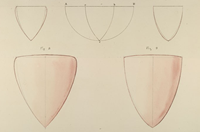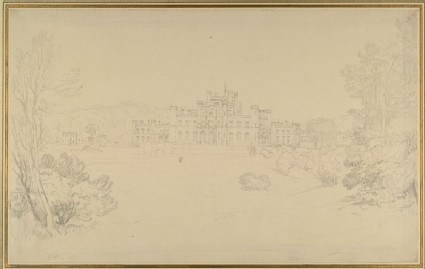Ruskin's Rudimentary series, 5th ed. (1873)
Items marked 'M' are drawings "by my own Hand" (by Ruskin), P are photographs, E engravings and A by Ruskin's Assistant, Arthur Burgess.

Ruskin's Catalogues: 1 object
Show search help- Reference URL
Actions
Lowther Castle Turner
-
Ruskin text
R|131} Lowther. Finished pencil sketch from nature; the artist’s principal mode of study through his whole life. Turner. -
Details
- Artist/maker
-
Turner (Joseph Mallord William Turner) (1775 - 1851)
- Object type
- drawing
- Material and technique
- graphite on wove paper
- Associated place
-
- Europe › United Kingdom › England › Cumbria › Lowther › Lowther Castle › Lowther Castle (subject)
- Europe › United Kingdom › England › Cumbria › Lowther › Lowther Park › Lowther Park (subject)
- Inscription
- North V
- Provenance
-
The Rev. W. Kingsley; presented by Kingsley to John Ruskin; presented by John Ruskin to the Ruskin Drawing School (University of Oxford), 1875; transferred from the Ruskin Drawing School to the Ashmol
- No. of items
- 1
- Accession no.
- WA.RS.RUD.131
-
Subject terms allocated by curators:
Subjects
-
References in which this object is cited include:
References
Ruskin, John, The Ruskin Art Collection at Oxford: Catalogue of the Rudimentary Series, in the Arrangement of 1873, ed. Robert Hewison (London: Lion and Unicorn Press, 1984), cat. Rudimentary no. 131, RUD.131
Herrmann, Luke, Ruskin and Turner: A Study of Ruskin as a Collector of Turner, Based on His Gifts to the University of Oxford: Incorporating a Catalogue Raisonné of the Turner Drawings in the Ashmolean Museum (London: Faber & Faber, 1968), no. 74
Ruskin, John, Instructions in Practice of Elementary Drawing, Arranged with Reference to the First Series of Examples in the Drawings Schools of the University of Oxford (n.p., [1872]), cat. Rudimentary no. 131
Ruskin, John, Instructions in the Preliminary Exercises Arranged for the Lower Drawing-School (London: Smith, Elder, 1872), cat. Rudimentary no. 131
Ruskin, John, Instructions in the Preliminary Exercise Arranged For the Lower Drawing-School (London: Spottiswoode, 1873), cat. Rudimentary no. 131
Ruskin, John, ‘Rudimentary Series 1878’, 1878, Oxford, Oxford University Archives, cat. Rudimentary no. 114
Ruskin, John, ‘The Ruskin Art Collection at Oxford: Catalogues, Notes and Instructions’, Edward T. Cook and Alexander Wedderburn, eds, The Works of John Ruskin: Library Edition, 39 (London: George Allen, 1903-1912), 21, cat. Rudimentary no. 131
Location
-
- Western Art Print Room
Position in Ruskin’s Collection
Ruskin's Catalogues
-
Ruskin's Rudimentary series, 3rd ed. (1872)
R|131} Lowther. Finished pencil sketch from nature; the artist’s principal mode of study through his whole life. Turner. -
Ruskin's Rudimentary series 4th ed. (1872)
R|131} Lowther. Finished pencil sketch from nature; the artist’s principal mode of study through his whole life. Turner. -
Ruskin's Rudimentary series, 5th ed. (1873)
R|131} Lowther. Finished pencil sketch from nature; the artist’s principal mode of study through his whole life. Turner. -
Ruskin's revision to the Rudimentary series (1878)
Now 131 114.The examples we have hitherto reviewed have been chosen chiefly to illustrate the history and principles of art. For completion of the evidence they have given us I must now refer to the Standard Series, and I place in the remainder of the cabinets exercises for immediate practice and illustrations of the natural history and landscape which, as frequently stated in my lectures, I think the best subjects of art for amateur students. It is always to be remembered that this collection is prepared for the art-education of young people generally, and not at all as a means of professional discipline for the artist, whom, as often stated in my lectures, I expect to study in the academies of artists and not in mine. This first drawing of the series so selected, an early pencil-sketch by Turner, from nature, is made the introduction to everything in order to enforce on our students the first great law of practice, that unR. til you can manage the point of the pencil, you need never hope to manage anything else. Assuming, however, that the exercises which have been gone through during the study of the above described examples have sufficiently disciplined the students’, hand, he is to copy the cluster of trees on the left hand of this drawing as an introduction to landscape-sketching.





